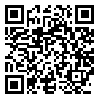Volume 9, Issue 1 (spring 2005)
2005, 9(1): 143-155 |
Back to browse issues page
Download citation:
BibTeX | RIS | EndNote | Medlars | ProCite | Reference Manager | RefWorks
Send citation to:



BibTeX | RIS | EndNote | Medlars | ProCite | Reference Manager | RefWorks
Send citation to:
M. Shahmohamadi, H. Dehghani, A. Yousefi. Stability Analysis of Barley (Hordeum vulgare L.) Genotypes in Regional Trials in Cold Zone. Journal of Crop Production and Processing 2005; 9 (1) :143-155
URL: http://jcpp.iut.ac.ir/article-1-287-en.html
URL: http://jcpp.iut.ac.ir/article-1-287-en.html
Abstract: (19742 Views)
To determine yield stability and to evaluate genotype interaction with environment interaction, 18 genotype of barley (Hordeum vulgare L.) and a control group were evaluated in a randomized complete block design with 4 replications in 3 successive years (1997-2000) at 10 research stations. Simple and combined analysis of variance revealed significant genetic differences between yield genotypes for grain yield. The results of combined analysis of variance indicated that genotypic and genotype were significant through interaction with environment. Therefore, different stability parameters including, environmental variance (S2i), environmental coefficient of variation (C.Vi), mean of variance of interaction (θi), interaction variance (θi), equivalence ( W2i), stability variance (σ2i), linear regression coefficient (bi, βi), mean of squares of deviation from regression (S2 di) and years within location MS for a genotype, averaging over all locations (MSy/l) were determined. Based on all the stability parameters, genotype 18 was known as the most stable one and genotypes 17 and 11 ranked lower. Genotype 5 with the highest yield was known to be the most adaptable one at fertile environments and is recommended for these locations. In addition, genotype 9 with good yield and low yield variance (1.58) and regression coefficient of less than 1 is suggested for unfertile locations.
Keywords: Genotype * environment interaction, Stability analysis, Barley, Adaptation, Stability parameter
| Rights and permissions | |
 | This work is licensed under a Creative Commons Attribution-NonCommercial 4.0 International License. |






